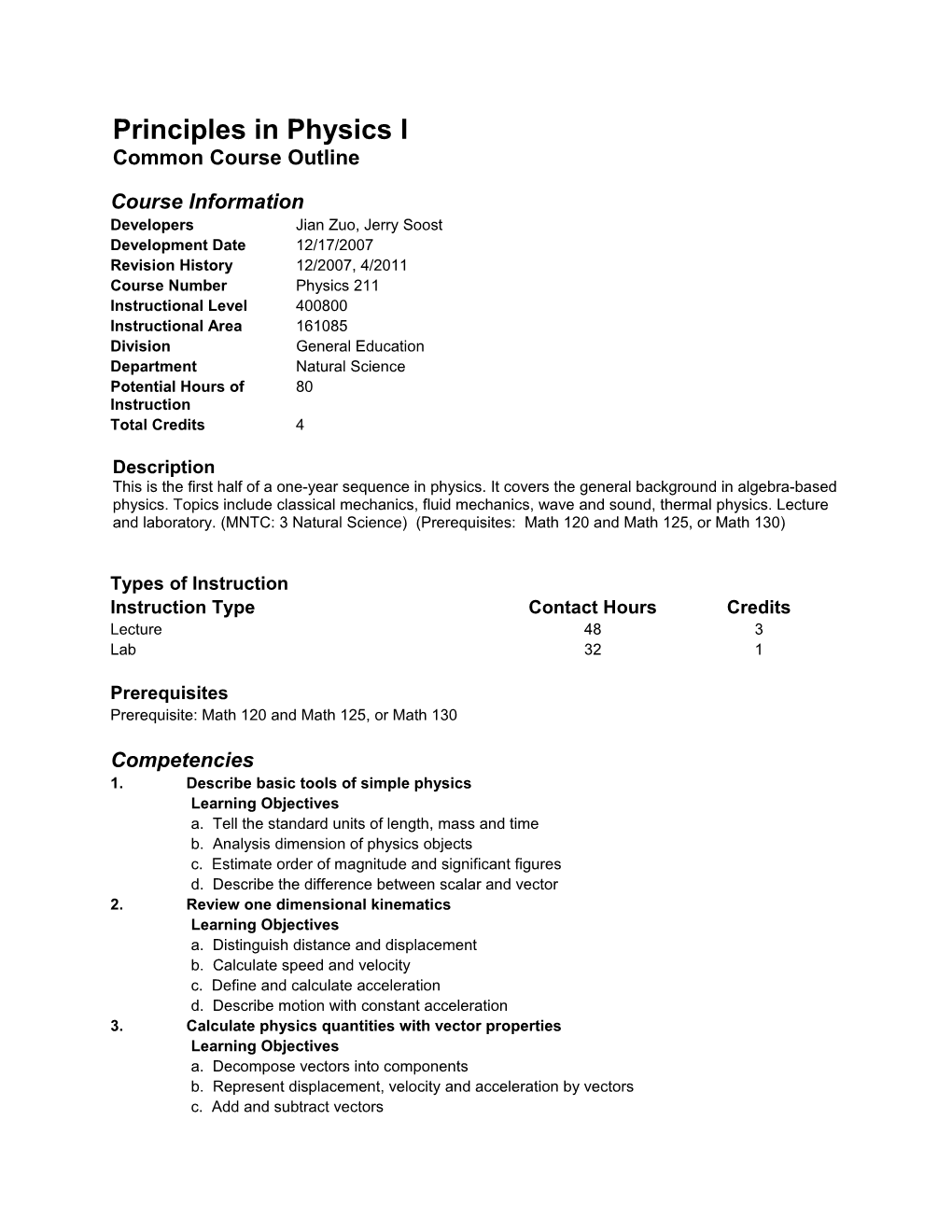Principles in Physics I
Common Course Outline
Developers / Jian Zuo, Jerry Soost
Development Date / 12/17/2007
Revision History / 12/2007, 4/2011
Course Number / Physics 211
Instructional Level / 400800
Instructional Area / 161085
Division / General Education
Department / Natural Science
Potential Hours of Instruction / 80
Total Credits / 4
Description
This is the first half of a one-year sequence in physics. It covers the general background in algebra-based physics. Topics include classical mechanics, fluid mechanics, wave and sound, thermal physics. Lecture and laboratory. (MNTC: 3 Natural Science) (Prerequisites: Math 120 and Math 125, or Math 130)
Instruction Type / Contact Hours / Credits
Lecture / 48 / 3
Lab / 32 / 1
Prerequisites
Prerequisite: Math 120 and Math 125, or Math 130
Competencies
1. / Describe basic tools of simple physics
Learning Objectives
a.Tell the standard units of length, mass and time
b.Analysis dimension of physics objects
c.Estimate order of magnitude and significant figures
d.Describe the difference between scalar and vector
2. / Review one dimensional kinematics
Learning Objectives
a.Distinguish distance and displacement
b.Calculate speed and velocity
c.Define and calculate acceleration
d.Describe motion with constant acceleration
3. / Calculate physics quantities with vector properties
Learning Objectives
a.Decompose vectors into components
b.Represent displacement, velocity and acceleration by vectors
c.Add and subtract vectors
4. / Describe two dimensional kinematics
Learning Objectives
a.List the basic equations of projectile motion
b.Decompose displacement and velocity vectors in projectile motion
c.Describe the key characteristics of projectile motion
5. / Apply Newton's laws of motion
Learning Objectives
a.Define force and mass
b.Describe Newton's laws of motion
c.Distinguish mass and weight
d.Study normal force, frictional forces and elastic force
e.Define the key physics quantities in circular motion
6. / Define work and energy
Learning Objectives
a.Investigate works done by various forces
b.Calculate power
c.Define kinetic energy, potential energy
d.Describe conservation of mechanic energy
7. / Investigate impulse and linear momentum
Learning Objectives
a.Define impulse and linear momentum
b.Describe impulse-momentum theorem
c.Decribe conservation of linear momentum
d.Investigate elastic and inelastic collisions
e.Find center of mass in a system
f.Study systems with changing mass
8. / Study rotational motion
Learning Objectives
a.Define angular displacement, velocity and acceleration
b.Calculate moment of inertia
c.Compute rotational kinetic energy
d.Define torque
e.Describe conditions of static equilibrium
f.Investigate angular momentum and the conservation of angular momentum
9. / Analyze basic gravity phenomenon
Learning Objectives
a.State Newton's law of universal gravitation
b.Compute the gravitational attraction of spherical bodies
c.Describe Kepler's laws of orbital motion
d.Calculate gravitational potential energy
e.Demonstrate tidal behaviors
10. / Describe oscillations
Learning Objectives
a.Define period and frequency
b.Illustrate simple harmonic motion
c.Analyze energy changes in oscillations
d.Describe damped oscillations
e.Depict driven oscillations and resonance
11. / Examine waves and sound
Learning Objectives
a.Distinguish transverse and longitudinal waves
b.Define wavelength and speed of wave
c.Analyze sound waves
d.Demonstrate the Doppler effect
e.Describe superposition and interference
f.Depict standing waves
12. / Study fluid mechanics
Learning Objectives
a.Define density and pressure
b.Show relation between pressure and depth in fluids
c.Demonstrate buoyant force
d.Apply Archimedes' principle
e.Examine Bernoulli's equation
13. / Investigate heat and temperature
Learning Objectives
a.List temperature scales
b.Describe thermal expansion
c.Calculate specific heat
d.Depict conduction, convection and radiation
14. / Demonstrate phases and phase changes
Learning Objectives
a.List different phases of matter
b.Describe ideal gas
c.Describe phase changes
d.Calculate latent heat
15. / Describe the laws of thermodynamics
Learning Objectives
a.Describe the laws of thermodynamics
b.Illustrate various thermal processes
c.Analyze heat engine and the Carnot cycle
d.Define entropy
